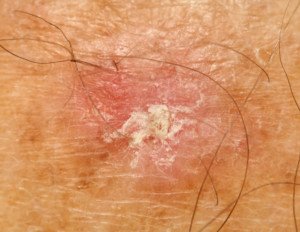
The answer to the question if skin cancer can come and go is rather tricky.
Skin cancer coming and going would refer to malignant cells being there one day and then withering away shortly after without any treatment.
And then returning again in the same spot. This has not been shown to occur with the deadliest form of skin cancer, melanoma.
It has also not been shown to occur with another type of skin cancer called squamous cell carcinoma – there are no cases confirming that this particular cancer was literally coming and going without treatment.
The same can be said for the most common cancer in the world, a skin growth known as basal cell carcinoma.
However…the concept of a skin cancer coming and going – appearing and disappearing spontaneously without treatment – might be applicable to precancerous lesions.
“Your immune system will help destroy some early stages of skin cancer like actinic keratosis,” says Janet Prystowsky, MD, board certified dermatologist in New York, NY, with 30+ years’ experience.
Dr. Prystowsky adds, “The growth may recur, however. The process may repeat itself.”
Actinic Keratosis
Actinic keratosis (image at top) is sun damage that occurs many years, sometimes several decades, after accumulated sun exposures earlier in life or younger adulthood.

Freepik.com, halayalex
But is actinic keratosis literally a cancer? Or is it a precancer?
Some dermatologists believe it’s closer to a precancerous state than an actual malignancy.
While other dermatologists believe that actinic keratosis is on the same continuum as squamous cell carcinoma, and that, in fact, it’s a very early form of squamous cell carcinoma.

Actinic keratosis on the ear. Future FamDoc, CreativeCommons
If left untreated, about 10 percent of actinic keratoses transform into squamous cell carcinoma. This transformation takes years.
The treatment of actinic keratoses is either a spray of liquid nitrogen to kill the abnormal cells; application of an ointment to kill the cells via physical contact; or application of an ointment designed to trigger an immune response to kill off the cells.
Dr. Prystowsky says, “Be concerned about anything coming and going. It may come and stay one day. Do not assume it is a benign process.
“If you notice any mole that is behaving strangely, speak to your dermatologist.”
A melanoma may appear to come and go, then come back, if the top visible portion gets accidently scraped off – say, in a bicycle accident.
But you’d need to have been aware of its pre-existing appearance beforehand to know that it “appeared and then disappeared.”
But in this hypothetical situation, only the visible portion got scraped away.
There’d still be cancer cells beneath the surface of the skin remaining, and continuing to proliferate.
Eventually this growth would result in a reappearance of the suspicious portion, creating the illusion that something is coming and going and then coming again.
Don’t let an apparent come and go nature of what you think might be cancer stop you from having the spot checked out by a dermatologist – and in person, not via transmitted phone images.

In combination with her focus on early skin cancer detection and removal, Dr. Prystowsky provides a wide range of revitalizing and rejuvenating treatments.
 Lorra Garrick has been covering medical, fitness and cybersecurity topics for many years, having written thousands of articles for print magazines and websites, including as a ghostwriter. She’s also a former ACE-certified personal trainer.
Lorra Garrick has been covering medical, fitness and cybersecurity topics for many years, having written thousands of articles for print magazines and websites, including as a ghostwriter. She’s also a former ACE-certified personal trainer.











